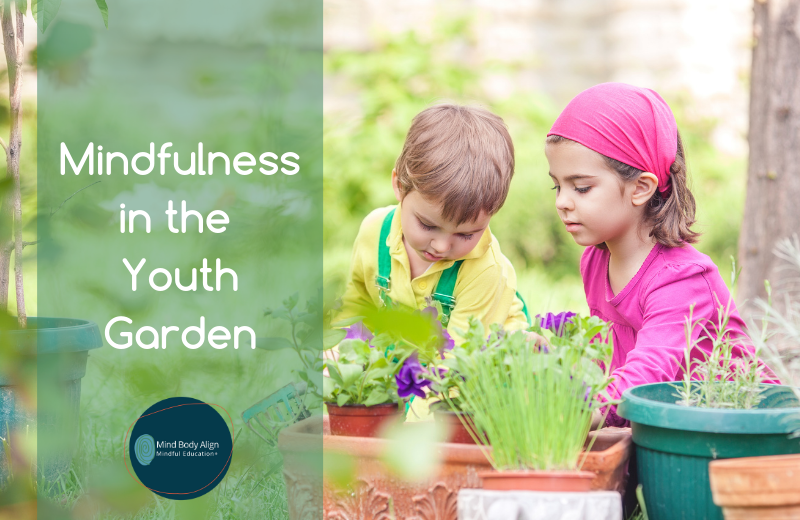I was up unusually early this sunny Saturday morning, having invited myself on a field trip with my daughter, who was meeting my sister for a garden tour. There was a time years ago when I was always up and out of the house early on Saturday mornings. My husband was traveling weekly back and forth between California and our home in Ohio for his work with Technicolor. He often arrived home in the wee hours, and I noticed that he appreciated extra rest, especially because our children, young at the time, were not inclined to respect his desire to sleep in.
On this day, Nina and I were off to the west side of Columbus, Ohio, to the Highland Youth Garden. After a coffee stop, and thankful for light weekend traffic, we found the garden, its presence marked by the large greenhouse and colorful signs. We parked near a school and walked over to where a small crowd gathered. I could feel myself relaxing as I took in the sights and sounds of the garden.
The mission of the Highland Youth Garden is to grow minds, grow food, and grow community in partnership with the Hilltop neighborhood of Columbus, Ohio. The seeds were planted in 2009 when a local recreation center closed, and local educators and lovers-of-gardening began growing food and teaching children on the plot. Now, they have one of the largest high tunnels in the city, an outdoor education center, and a nearly half-acre plot full of artful arbors, structures, and crops.
The garden is a way to meet multiple community goals. The intention is to provide fresh vegetables in an area that suffers from food scarcity. Additional goals are to engage youth in the area to teach them life skills, how to create a sustainable garden even in containers and small spaces, and the benefits of growing their own food.
One thing the garden team has learned is that working in the garden- often just a visit to the garden- has a way of helping people feel better. Working in soil and gardening are long known to be meditative and help people work through trauma.
I found the garden extremely calming. All my senses were heightened. I picked and tasted asparagus, and it was delicious, fresh and raw. What a revelation! I could smell the earth. The colors looked so vibrant. All the sights and sounds were captivating. The volunteers were each so different, diverse, and beautiful- even a young girl with a pink unicorn shirt and pigtails, who was perhaps growing a little thirsty this warm morning and was just a bit short-tempered as she worked side-by-side with her mom.
Successful gardening requires mindfulness, of course. And in this garden, mindfulness is in practice everywhere. The garden was just planted, and sprouts were in neat, orderly rows. Everyone whom I met had a thoughtful way about them, including the vibrant master gardener. She spoke of how their programs impact children, and how they host groups from the school and the neighborhood year-round.
We all have an innate desire to be safe. For children, including teenagers, talking and especially telling about difficult things occurs during activity with someone they trust. For my children, they often opened up when we were cleaning up after dinner, or driving in the car. Similarly, time spent working the soil and in the garden often helps youth feel safe, open up, and talk.
I heard a compelling story about the morning after a nearby drug raid, when a child walked over to the garden and started silently working the soil. After a while, she spoke, sharing about how scary it was to have police raid an apartment in her building where she could hear and see the event go down. It would take a long time for that scary trauma to process, I imagine. Sadly, events like that are not uncommon in the area around the garden. But the garden is a refuge, it seems.
It is hard to navigate life without experiencing trauma. Nevertheless, even just a bit of nature yields mindful benefits. In mindful.org, there is a report where participants reported lower stress, increased feelings of well-being, and greater happiness due to newly blooming plants in their yards. One amazing outcome shared in that article related to saliva tests of participants, which indicated lower levels of the stress hormone cortisol in those who received plants, compared to a control group who did not.
How amazing to tackle stress, food scarcity, and trauma- all at once.
Every day, Shelly Casto and her team teach youth how to garden and skills to navigate life. We were excited to share some of Mind Body Align’s new mindful teaching products with them.
If you are in the Columbus, Ohio, area consider a visit to the garden at 67 South Highland Avenue.
No garden nearby? Our Sights and Sounds of Nature visualization activity is the perfect practice for anyone, every age, anytime. I love these visualizations, even if they are designed with children in mind. The proven benefits of mindful visualization are many. Relief from anxiety, greater compassion, and improved ability to cope with stress are a few benefits. Included in this slideshow are 10 colorful videos of NATURE. Each beautiful video includes prompts encouraging children to focus on 3 of the 5 SENSES. Some slides display visual images and others add sound. All the slides encourage students to remember or imagine sounds, sights, and feelings. With each viewing, attention refocuses on another of the three senses. Sights and sounds included in this deck are light rain, a frog, crickets, wind, heavy rain, a worm, bees, a mud puddle, thunder, and a waterfall.
Find more of our mindful teaching products here and shop our experiences here. Join us every Wednesday at 8:15 am EST for a free, 15-minute virtual mindfulness practice; Connect In using the link at mindbodyalign.com.










